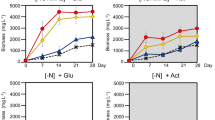Abstract
The bioplastic poly(3-hydroxybutyrate-co-3-hydroxyvalerate) (PHBV) changes material properties upon altering mole ratio (mol%) of the two monomers: 3-hydroxybutyrate (HB) and 3-hydroxyvalerate (HV). Biotechnology for producing PHBV with a wide range of HV mol% using low amount of organic substrate is required. Here, 20 evolutionarily divergent cyanobacteria were examined for PHBV production. Under photoautotrophy with carbon dioxide (CO2) supply, one strain produced PHBV. But under heterotrophy using a medium containing only one type of organic substrate, 4, 15, and 13 strains were found to accumulate PHBV when supplied with acetate (C2H3O2), propionate (C3H5O2), and valerate (C5H9O2), respectively. Hence, these cyanobacterial PHBV productions required only CO2 or a single type of organic substrate. The obtained PHBV showed a broad range of HV mole ratios from 4 to 96 mol%. The cells producing PHBV with high HV mole ratios (31–96 mol%) exhibited low cellular acetyl-CoA levels. The PHBV with a 96.2 mol% HV and 3.8 mol% HB from Nostoc microscopicum elongated at 98 ± 15% (length/length), a 19.6-fold higher elongation than that of commercial poly-3-hydroxybutyrate containing 100 mol% HB. The results demonstrated the economical utility of cyanobacterial conversion of CO2 and a single organic substrate to synthesize PHBV with improved elongation quality.


Similar content being viewed by others
References
Bhati R, Mallick N (2012) Production and characterization of poly(3-hydroxybutyrate-co-3-hydroxyvalerate) co-polymer by a N2-fixing cyanobacterium, Nostoc muscorum Agardh. J Chem Technol Biotechnol 87:505–512
Bhati R, Mallick N (2015) Poly(3-hydroxybutyrate-co-3-hydroxyvalerate) copolymer production by the diazotrophic cyanobacterium Nostoc muscorum Agardh: process optimization and polymer characterization. Algal Res 7:78–85
Bhati R, Samantaray S, Sharma L, Mallick N (2010) Poly-beta-hydroxybutyrate accumulation in cyanobacteria under photoautotrophy. Biotechnol J 5:1181–1185
Chanprateep S (2010) Current trends in biodegradable polyhydroxyalkanoates. J Biosci Bioeng 110:621–632
Chanprateep S, Kulpreecha S (2006) Production and characterization of biodegradable terpolymer poly(3-hydroxybutyrate-co-3-hydroxyvalerate-co-4-hydroxybutyrate) by Alcaligenes sp. A-04. J Biosci Bioeng 101:51–56
Duncan DB (1955) Multiple range and multiple F tests. Biometrics 11:1–42
Huijberts GNM, Vanderwal H, Wilkinson C, Eggink G (1994) Gas-chromatographic analysis of poly(3-hydroxyalkanoates) in bacteria. Biotechnol Tech 8:187–192
Kaewbai-Ngam A, Incharoensakdi A, Monshupanee T (2016) Increased accumulation of polyhydroxybutyrate in divergent cyanobacteria under nutrient-deprived photoautotrophy: an efficient conversion of solar energy and carbon dioxide to polyhydroxybutyrate by Calothrix scytonemicola TISTR 8095. Bioresour Technol 212:342–347
Koller M, Maršálek L (2015) Cyanobacterial polyhydroxyalkanoate production: status quo and quo vadis? Curr Biotechnol 4:464–480
Lee SY (1996) Bacterial polyhydroxyalkanoates. Biotechnol Bioeng 49:1–14
Majid MI, Akmal DH, Few LL, Agustien A, Toh MS, Samian MR, Najimudin N, Azizan MN (1999) Production of poly(3-hydroxybutyrate) and its copolymer poly(3-hydroxybutyrate-co-3-hydroxyvalerate) by Erwinia sp. USMI-20. Int J Biol Macromol 25:95–104
Monshupanee T, Incharoensakdi A (2014) Enhanced accumulation of glycogen, lipids and polyhydroxybutyrate under optimal nutrients and light intensities in the cyanobacterium Synechocystis sp. PCC 6803. J Appl Microbiol 116:830–838
Monshupanee T, Nimdach P, Incharoensakdi A (2016) Two-stage (photoautotrophy and heterotrophy) cultivation enables efficient production of bioplastic poly-3-hydroxybutyrate in auto-sedimenting cyanobacterium. Sci Rep 6:37121
Poirier Y (2002) Polyhydroxyalknoate synthesis in plants as a tool for biotechnology and basic studies of lipid metabolism. Prog Lipid Res 41:131–155
Ranaivoarisoa TO, Singh R, Rengasamy K, Guzman MS, Bose A (2019) Towards sustainable bioplastic production using the photoautotrophic bacterium Rhodopseudomonas palustris TIE-1. J Ind Microbiol Biotechnol 46:1401–1417
Samantaray S, Mallick N (2015) Role of cultural variables in tailoring poly(3-hydroxybutyrate-co-3-hydroxyvalerate) copolymer synthesis in the diazotrophic cyanobacterium Aulosira fertilissima CCC 444. J Appl Phycol 27:197–203
Schirrmeister BE, Antonelli A, Bagheri HC (2011) The origin of multicellularity in cyanobacteria. BMC Evol Biol 11:45
Singh AK, Mallick N (2017) Advances in cyanobacterial polyhydroxyalkanoates production. FEMS Microbiol Lett 364
Taepucharoen K, Tarawat S, Puangcharoen M, Incharoensakdi A, Monshupanee T (2017) Production of poly(3-hydroxybutyrate-co-3-hydroxyvalerate) under photoautotrophy and heterotrophy by non-heterocystous N2-fixing cyanobacterium. Bioresour Technol 239:523–527
Taroncher-Oldenburg G, Nishina K, Stephanopoulos G (2000) Identification and analysis of the polyhydroxyalkanoate-specific beta-ketothiolase and acetoacetyl coenzyme A reductase genes in the cyanobacterium Synechocystis sp. strain PCC6803. Appl Environ Microbiol 66:4440–4448
Thiel K, Vuorio E, Aro EM, Kallio PT (2017) The effect of enhanced acetate influx on Synechocystis sp. PCC 6803 metabolism. Microb Cell Fact 16:21
Tomitani A, Knoll AH, Cavanaugh CM, Ohno T (2006) The evolutionary diversification of cyanobacteria: molecular-phylogenetic and paleontological perspectives. Proc Natl Acad Sci U S A 103:5442–5447
Valentin HE, Steinbuchel A (1994) Application of enzymatically synthesized short-chain-length hydroxy fatty acid coenzyme A thioesters for assay of polyhydroxyalkanoic acid synthases. Appl Microbiol Biotechnol 40:699–709
Verlinden RA, Hill DJ, Kenward MA, Williams CD, Radecka I (2007) Bacterial synthesis of biodegradable polyhydroxyalkanoates. J Appl Microbiol 102:1437–1449
Wang HH, Zhou XR, Liu Q, Chen GQ (2011) Biosynthesis of polyhydroxyalkanoate homopolymers by Pseudomonas putida. Appl Microbiol Biotechnol 89:1497–1507
Wang Y, Zhu Y, Gu P, Li Y, Fan X, Song D, Ji Y, Li Q (2017) Biosynthesis of poly (3-hydroxybutyrate-co-3-hydroxyvalerate) by bacterial community from propylene oxide saponification wastewater residual sludge. Int J Biol Macromol 98:34–38
Yang YH, Brigham CJ, Song E, Jeon JM, Rha CK, Sinskey AJ (2012) Biosynthesis of poly(3-hydroxybutyrate-co-3-hydroxyvalerate) containing a predominant amount of 3-hydroxyvalerate by engineered Escherichia coli expressing propionate-CoA transferase. J Appl Microbiol 113:815–823
Yellore V, Desai A (1998) Production of poly-3-hydroxybutyrate from lactose and whey by Methylobacterium sp. ZP24. Lett Appl Microbiol 26:391–394
Acknowledgments
The authors thank Dr. Robert Butcher for critical reading and TISTR for technical support.
Funding
This work was supported by the Ratchadaphiseksomphot Endowment Fund of Chulalongkorn University (CU) grant CU-GR-62-03-23-02. T.M. and S.T. thank the 90th Anniversary Fund of CU (GCUGR1125594053M).
Author information
Authors and Affiliations
Corresponding author
Ethics declarations
Competing interests
The authors declare that they have no competing interests.
Additional information
Publisher’s note
Springer Nature remains neutral with regard to jurisdictional claims in published maps and institutional affiliations.
Electronic supplementary material
ESM 1
(PDF 929 kb)
Rights and permissions
About this article
Cite this article
Tarawat, S., Incharoensakdi, A. & Monshupanee, T. Cyanobacterial production of poly(3-hydroxybutyrate-co-3-hydroxyvalerate) from carbon dioxide or a single organic substrate: improved polymer elongation with an extremely high 3-hydroxyvalerate mole proportion. J Appl Phycol 32, 1095–1102 (2020). https://doi.org/10.1007/s10811-020-02040-4
Received:
Revised:
Accepted:
Published:
Issue Date:
DOI: https://doi.org/10.1007/s10811-020-02040-4




